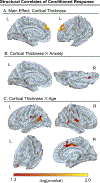Anticipatory Threat Responding: Associations With Anxiety, Development, and Brain Structure
- PMID: 31955915
- PMCID: PMC7211142
- DOI: 10.1016/j.biopsych.2019.11.006
Anticipatory Threat Responding: Associations With Anxiety, Development, and Brain Structure
Abstract
Background: While translational theories link neurodevelopmental changes in threat learning to pathological anxiety, findings from studies in patients inconsistently support these theories. This inconsistency may reflect difficulties in studying large patient samples with wide age ranges using consistent methods. A dearth of imaging data in patients further limits translational advances. We address these gaps through a psychophysiology and structural brain imaging study in a large sample of patients across the lifespan.
Methods: A total of 351 participants (8-50 years of age; 209 female subjects; 195 healthy participants and 156 medication-free, treatment-seeking patients with anxiety) completed a differential threat conditioning and extinction paradigm that has been validated in pediatric and adult populations. Skin conductance response indexed psychophysiological response to conditioned (CS+, CS-) and unconditioned threat stimuli. Structural magnetic resonance imaging data were available for 250 participants. Analyses tested anxiety and age associations with psychophysiological response in addition to associations between psychophysiology and brain structure.
Results: Regardless of age, patients and healthy comparison subjects demonstrated comparable differential threat conditioning and extinction. The magnitude of skin conductance response to both conditioned stimulus types differentiated patients from comparison subjects and covaried with dorsal prefrontal cortical thickness; structure-response associations were moderated by anxiety and age in several regions. Unconditioned responding was unrelated to anxiety and brain structure.
Conclusions: Rather than impaired threat learning, pathological anxiety involves heightened skin conductance response to potential but not immediately present threats; this anxiety-related potentiation of anticipatory responding also relates to variation in brain structure. These findings inform theoretical considerations by highlighting anticipatory response to potential threat in anxiety.
Trial registration: ClinicalTrials.gov NCT00018057.
Keywords: Anticipation; Anxiety; Conditioning; Development; Extinction; Threat.
Published by Elsevier Inc.
Conflict of interest statement
Financial Disclosures
All authors report no biomedical financial interests or potential conflicts of interest.
Figures



Comment in
-
Aversive Stimulus Pairings Are an Unnecessary and Insufficient Cause of Pathological Anxiety.Biol Psychiatry. 2020 May 15;87(10):870-871. doi: 10.1016/j.biopsych.2020.03.006. Biol Psychiatry. 2020. PMID: 32381156 No abstract available.
References
-
- Barlow DH (2002): Anxiety and Its Disorders: The Nature and Treatment of Anxiety and Panic. New York: The Guilford Press.
-
- Duits P, Cath DC, Lissek S, Hox JJ, Hamm AO, Engelhard IM, et al. (2015): Updated meta-analysis of classical fear conditioning in the anxiety disorders. Depression and Anxiety. 32:239–253. - PubMed
-
- Mineka S, Oehlberg K (2008): The relevance of recent developments in classical conditioning to understanding the etiology and maintenance of anxiety disorders. Acta Psychologica (Amst). 127:567–580. - PubMed
-
- Waters AM, Craske MG (2016): Towards a cognitive-learning formulation of youth anxiety: A narrative review of theory and evidence and implications for treatment. Clinical Psychology Review. 50:50–66. - PubMed

